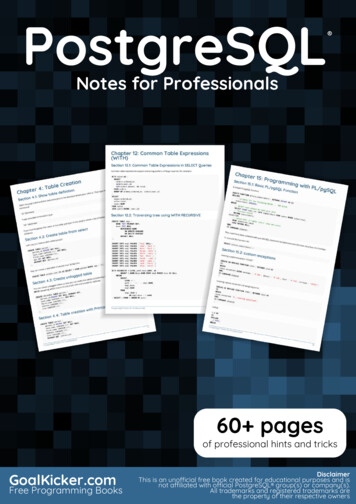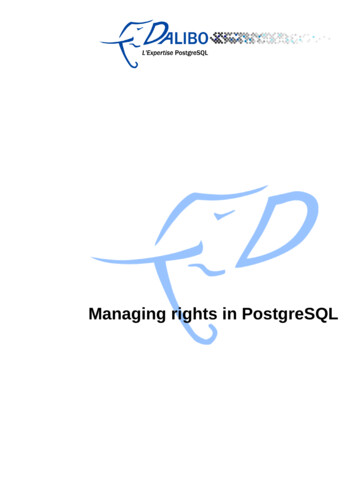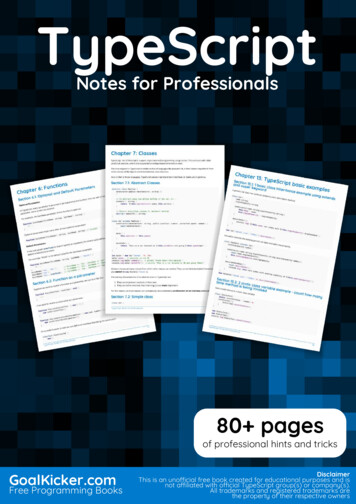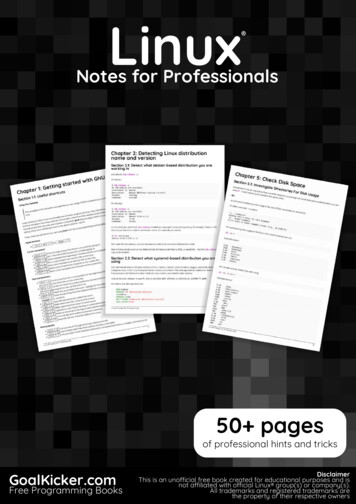
Transcription
PostgreSQLPostgreSQLNotes for Professionals Notes for Professionals60 pagesof professional hints and tricksGoalKicker.comFree Programming BooksDisclaimerThis is an uno cial free book created for educational purposes and isnot a liated with o cial PostgreSQL group(s) or company(s).All trademarks and registered trademarks arethe property of their respective owners
ContentsAbout . 1Chapter 1: Getting started with PostgreSQL . 2Section 1.1: Installing PostgreSQL on Windows . 2Section 1.2: Install PostgreSQL from Source on Linux . 3Section 1.3: Installation on GNU Linux . 4Section 1.4: How to install PostgreSQL via MacPorts on OSX . 5Section 1.5: Install postgresql with brew on Mac . 7Section 1.6: Postgres.app for Mac OSX . 7Chapter 2: Data Types . 8Section 2.1: Numeric Types . 8Section 2.2: Date/ Time Types . 8Section 2.3: Geometric Types . 9Section 2.4: Network Adress Types . 9Section 2.5: Character Types . 9Section 2.6: Arrays . 9Chapter 3: Dates, Timestamps, and Intervals . 11Section 3.1: SELECT the last day of month . 11Section 3.2: Cast a timestamp or interval to a string . 11Section 3.3: Count the number of records per week . 11Chapter 4: Table Creation . 12Section 4.1: Show table definition . 12Section 4.2: Create table from select . 12Section 4.3: Create unlogged table . 12Section 4.4: Table creation with Primary Key . 12Section 4.5: Create a table that references other table . 13Chapter 5: SELECT . 14Section 5.1: SELECT using WHERE . 14Chapter 6: Find String Length / Character Length . 15Section 6.1: Example to get length of a character varying field . 15Chapter 7: COALESCE . 16Section 7.1: Single non null argument . 16Section 7.2: Multiple non null arguments . 16Section 7.3: All null arguments . 16Chapter 8: INSERT . 17Section 8.1: Insert data using COPY . 17Section 8.2: Inserting multiple rows . 18Section 8.3: INSERT data and RETURING values . 18Section 8.4: Basic INSERT . 18Section 8.5: Insert from select . 18Section 8.6: UPSERT - INSERT . ON CONFLICT DO UPDATE. . 19Section 8.7: SELECT data into file . 19Chapter 9: UPDATE . 21Section 9.1: Updating a table based on joining another table . 21Section 9.2: Update all rows in a table . 21Section 9.3: Update all rows meeting a condition . 21Section 9.4: Updating multiple columns in table . 21
Chapter 10: JSON Support . 22Section 10.1: Using JSONb operators . 22Section 10.2: Querying complex JSON documents . 26Section 10.3: Creating a pure JSON table . 27Chapter 11: Aggregate Functions . 28Section 11.1: Simple statistics: min(), max(), avg() . 28Section 11.2: regr slope(Y, X) : slope of the least-squares-fit linear equation determined by the (X, Y) pairs. 28Section 11.3: string agg(expression, delimiter) . 29Chapter 12: Common Table Expressions (WITH) . 31Section 12.1: Common Table Expressions in SELECT Queries . 31Section 12.2: Traversing tree using WITH RECURSIVE . 31Chapter 13: Window Functions . 32Section 13.1: generic example . 32Section 13.2: column values vs dense rank vs rank vs row number . 33Chapter 14: Recursive queries . 34Section 14.1: Sum of Integers . 34Chapter 15: Programming with PL/pgSQL . 35Section 15.1: Basic PL/pgSQL Function . 35Section 15.2: custom exceptions . 35Section 15.3: PL/pgSQL Syntax . 36Section 15.4: RETURNS Block . 36Chapter 16: Inheritance . 37Section 16.1: Creating children tables . 37Chapter 17: Export PostgreSQL database table header and data to CSV file . 38Section 17.1: copy from query . 38Section 17.2: Export PostgreSQL table to csv with header for some column(s) . 38Section 17.3: Full table backup to csv with header . 38Chapter 18: Triggers and Trigger Functions . 39Section 18.1: Type of triggers . 39Section 18.2: Basic PL/pgSQL Trigger Function . 40Chapter 19: Event Triggers . 42Section 19.1: Logging DDL Command Start Events . 42Chapter 20: Role Management . 43Section 20.1: Create a user with a password . 43Section 20.2: Grant and Revoke Privileges . 43Section 20.3: Create Role and matching database . 44Section 20.4: Alter default search path of user . 44Section 20.5: Create Read Only User . 45Section 20.6: Grant access privileges on objects created in the future . 45Chapter 21: Postgres cryptographic functions . 46Section 21.1: digest . 46Chapter 22: Comments in PostgreSQL . 47Section 22.1: COMMENT on Table . 47Section 22.2: Remove Comment . 47Chapter 23: Backup and Restore . 48Section 23.1: Backing up one database . 48Section 23.2: Restoring backups . 48
Section 23.3: Backing up the whole cluster . 48Section 23.4: Using psql to export data . 49Section 23.5: Using Copy to import . 49Section 23.6: Using Copy to export . 50Chapter 24: Backup script for a production DB . 51Section 24.1: saveProdDb.sh . 51Chapter 25: Accessing Data Programmatically . 52Section 25.1: Accessing PostgreSQL with the C-API . 52Section 25.2: Accessing PostgreSQL from python using psycopg2 . 55Section 25.3: Accessing PostgreSQL from .NET using the Npgsql provider . 55Section 25.4: Accessing PostgreSQL from PHP using Pomm2 . 56Chapter 26: Connect to PostgreSQL from Java . 58Section 26.1: Connecting with java.sql.DriverManager . 58Section 26.2: Connecting with java.sql.DriverManager and Properties . 58Section 26.3: Connecting with javax.sql.DataSource using a connection pool . 59Chapter 27: PostgreSQL High Availability . 61Section 27.1: Replication in PostgreSQL . 61Chapter 28: EXTENSION dblink and postgres fdw . 64Section 28.1: Extention FDW . 64Section 28.2: Foreign Data Wrapper . 64Section 28.3: Extention dblink . 65Chapter 29: Postgres Tip and Tricks . 66Section 29.1: DATEADD alternative in Postgres . 66Section 29.2: Comma separated values of a column . 66Section 29.3: Delete duplicate records from postgres table . 66Section 29.4: Update query with join between two tables alternative since Postresql does not support joinin update query . 66Section 29.5: Di erence between two date timestamps month wise and year wise . 66Section 29.6: Query to Copy/Move/Transafer table data from one database to other database table withsame schema . 67Credits . 68You may also like . 70
AboutPlease feel free to share this PDF with anyone for free,latest version of this book can be downloaded from:https://goalkicker.com/PostgreSQLBookThis PostgreSQL Notes for Professionals book is compiled from Stack OverflowDocumentation, the content is written by the beautiful people at Stack Overflow.Text content is released under Creative Commons BY-SA, see credits at the endof this book whom contributed to the various chapters. Images may be copyrightof their respective owners unless otherwise specifiedThis is an unofficial free book created for educational purposes and is notaffiliated with official PostgreSQL group(s) or company(s) nor Stack Overflow.All trademarks and registered trademarks are the property of their respectivecompany ownersThe information presented in this book is not guaranteed to be correct noraccurate, use at your own riskPlease send feedback and corrections to web@petercv.comGoalKicker.com – PostgreSQL Notes for Professionals1
Chapter 1: Getting started with PostgreSQLVersion Release date EOL date10.02017-10-05 n 1.1: Installing PostgreSQL on WindowsWhile it's good practice to use a Unix based operating system (ex. Linux or BSD) as a production server you caneasily install PostgreSQL on Windows (hopefully only as a development server).Download the Windows installation binaries from services-training/pgdownload This is a third-party company started by corecontributors to the PostgreSQL project who have optimized the binaries for Windows.Select the latest stable (non-Beta) version (9.5.3 at the time of writing). You will most likely want the Win x86-64package, but if you are running a 32 bit version of Windows, which is common on older computers, select Winx86-32 instead.Note: Switching between Beta and Stable versions will involve complex tasks like dump and restore. Upgradingwithin beta or stable version only needs a service restart.You can check if your version of Windows is 32 or 64 bit by going to Control Panel - System and Security - System- System type, which will say "##-bit Operating System". This is the path for Windows 7, it may be slightly differenton other versions of Windows.In the installer select the packages you would like to use. For example:pgAdmin ( https://www.pgadmin.org ) is a free GUI for managing your database and I highly recommend it. In9.6 this will be installed by default .PostGIS ( http://postgis.net ) provides geospatial analysis features on GPS coordinates, distances etc. verypopular among GIS developers.The Language Package provides required libraries for officially supported procedural language PL/Python,PL/Perl and PL/Tcl.Other packages like pgAgent, pgBouncer and Slony are useful for larger production servers, only checked asneeded.All those optional packages can be later installed through "Application Stack Builder".Note: There are also other non-officially supported language such as PL/V8, PL/Lua PL/Java available.Open pgAdmin and connect to your server by double clicking on its name, ex. "PostgreSQL 9.5 (localhost:5432).From this point you can follow guides such as the excellent book PostgreSQL: Up and Running, 2nd Edition (http://shop.oreilly.com/product/0636920032144.do ).GoalKicker.com – PostgreSQL Notes for Professionals2
Optional: Manual Service Startup TypePostgreSQL runs as a service in the background which is slightly different than most programs. This is common fordatabases and web servers. Its default Startup Type is Automatic which means it will always run without any inputfrom you.Why would you want to manually control the PostgreSQL service? If you're using your PC as a development serversome of the time and but also use it to play video games for example, PostegreSQL could slow down your system abit while its running.Why wouldn't you want manual control? Starting and stopping the service can be a hassle if you do it often.If you don't notice any difference in speed and prefer avoiding the hassle then leave its Startup Type as Automaticand ignore the rest of this guide. Otherwise.Go to Control Panel - System and Security - Administrative Tools.Select "Services" from the list, right click on its icon, and select Send To - Desktop to create a desktop icon for moreconvenient access.Close the Administrative Tools window then launch Services from the desktop icon you just created.Scroll down until you see a service with a name like postgresql-x##-9.# (ex. "postgresql-x64-9.5").Right click on the postgres service, select Properties - Startup type - Manual - Apply - OK. You can change itback to automatic just as easily.If you see other PostgreSQL related services in the list such "pgbouncer" or "PostgreSQL Scheduling Agent pgAgent" you can also change their Startup Type to Manual because they're not much use if PostgreSQL isn'trunning. Although this will mean more hassle each time you start and stop so it's up to you. They don't use as manyresources as PostgreSQL itself and may not have any noticeable impact on your systems performance.If the service is running its Status will say Started, otherwise it isn't running.To start it right click and select Start. A loading prompt will be displayed and should disappear on its own soonafter. If it gives you an error try a second time. If that doesn't work then there was some problem with theinstallation, possibly because you changed some setting in Windows most people don't change, so finding theproblem might require some sleuthing.To stop postgres right click on the service and select Stop.If you ever get an error while attempting to connect to your database check Services to make sure its running.For other very specific details about the EDB PostgreSQL installation, e.g. the python runtime version in the officiallanguage pack of a specific PostgreSQL version, always refer to the official EBD installation guide , change theversion in link to your installer's major version.Section 1.2: Install PostgreSQL from Source on LinuxDependencies:GNU Make Version 3.80an ISO/ ANSI C-Compiler (e.g. gcc)an extractor like tar or gzipzlib-develGoalKicker.com – PostgreSQL Notes for Professionals3
readline-devel oder libedit-develSources: Link to the latest source (9.6.3)Now you can extract the source files:tar -xzvf postgresql-9.6.3.tar.gzThere are a large number of different options for the configuration of PostgreSQL:Full Link to the full installation procedureSmall list of available options:--prefix PATH path for all files--exec-prefix PATH path for architectur-dependet file--bindir PATH path for executable programs--sysconfdir PATH path for configuration files--with-pgport NUMBER specify a port for your server--with-perl add perl support--with-python add python support--with-openssl add openssl support--with-ldap add ldap support--with-blocksize BLOCKSIZE set pagesize in KBBLOCKSIZE must a power of 2 and between 1 and 32--with-wal-segsize SEGSIZE set size of WAL-Segment size in MBSEGSIZE must be a power of 2 between 1 and 64Go into the new created folder and run the cofigure script with the desired options:./configure --exec /usr/local/pgsqlRun make to create the objectfilesRun make install to install PostgreSQL from the built filesRun make clean to tidy upFor the extension switch the directory cd contrib, run make and make installSection 1.3: Installation on GNU LinuxOn most GNU Linux operating systems, PostgreSQL can easily be installed using the operating system packagemanager.Red Hat familyRespositories can be found here: d the repository to local machine with the commandyum -y install redhat/rhel-7-x86 64/pgdgredhatXX-X.X-X.noarch.rpmView available packages:GoalKicker.com – PostgreSQL Notes for Professionals4
yum list available grep postgres*Neccesary packages are: postgresqlXX postgresqlXX-server postgresqlXX-libs postgresqlXX-contribThese are installed with the following command: yum -y install postgresqlXX postgresqlXX-server postgresqlXX-libspostgresqlXX-contribOnce installed you will need to start the database service as the service owner (Default is postgres). This is donewith the pg ctl command.sudo -su postgres./usr/pgsql-X.X/bin/pg ctl -D /var/lib/pgsql/X.X/data startTo access the DB in CLI enter psqlDebian familyOn Debian and derived operating systems, type:sudo apt-get install postgresqlThis will install the PostgreSQL server package, at the default version offered by the operating system's packagerepositories.If the version that's installed by default is not the one that you want, you can use the package manager to searchfor specific versions which may simultaneously be offered.You can also use the Yum repository provided by the PostgreSQL project (known as PGDG) to get a differentversion. This may allow versions not yet offered by operating system package repositories.Section 1.4: How to install PostgreSQL via MacPorts on OSXIn order to install PostgreSQL on OSX, you need to know which versions are currently supported.Use this command to see what versions you have available.sudo port list grep " postgresql[[:digit:]]\{2\}[[:space:]]"You should get a list that looks something like the 96In this example, the most recent version of PostgreSQL that is supported in 9.6, so we will install that.GoalKicker.com – PostgreSQL Notes for Professionals5
sudo port install postgresql96-server postgresql96You will see an installation log like this:--- Computing dependencies for postgresql96-server--- Depend
PostgreSQL PostgreSQL Notes for Professionals Notes for Professionals GoalKicker.com Free Programming Books Disclaimer This is an uno cial free book created for educational purposes and is not a liated with o cial PostgreSQL group(s) or company(s). All trademarks and registered trademarks are the property of their respective owners 60 pages










